Honeysuckle
By Debs Cook
In my garden, I have three varieties of honeysuckle.
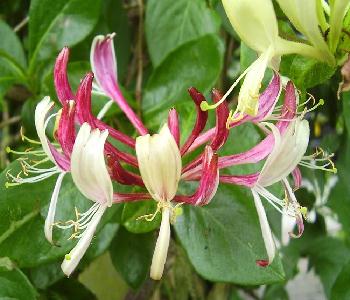
Lonicera periclymenum (L.)
- The first, planted a few year's ago from a friend's cutting, is the Perfoliate Honeysuckle (Lonicera caprifolium (L.)), also known to some as the Italian honeysuckle. It is called perfoliate because the leaves cradle the stem and appear to have the stem pushed through the centre. I grow it over the fence that separates my garden from my neighbour's. It flowers from early May until the end of June and smells so good that I find myself wandering down to that part of the garden frequently when it's in flower.
- The second is Lonicera japonica 'Halliana', planted last year over the garden arch. As the perfoliate honeysuckle is fading and making berries for the birds, the Halliana takes over with its delicious scent.
- The third is a golden variegated honeysuckle (Lonicera 'Aureoreticulata'). I haven't seen this one flower yet as it is a new plant from earlier this summer. It will probably not flower until next year but the leaves alone are pretty spectacular. According to the label, its flowers are also very fragrant and resemble those of Halliana.
History
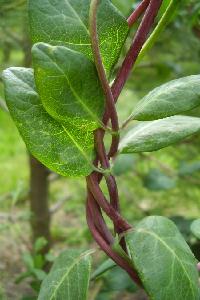
The name of the genus, Lonicera, was given to the honeysuckle family by Carl Linnaeus (1707-1778), the Swedish botanist, in honour of the German botanist Adam Loncier (1528-1586).
Honeysuckle can be found listed in the 'Tang Ben Cao', a Chinese herbal which is the earliest known existing pharmacopoeia written in AD 659. The Chinese used honeysuckle japonica which they called jin yin hua as a cleanser and for removing poisons from the body.
Honeysuckle has caused some confusion in its time. The poet Milton and the writer Chaucer amongst others referred to honeysuckle as Eglantine, a name more commonly attributed to the sweet briar rose by modern herbalists and people everywhere, except apparently for those in North Yorkshire where honeysuckle still goes by the name of Eglantine?
Other names for honeysuckle include woodbine, fairy trumpets, honeybind, trumpet flowers, goats leaf and sweet suckle. The old name Woodbine describes the twisting, binding nature of the honeysuckle through the hedgerows as can be seen from the photograph.
Folklore
In Scotland, it was believed that if honeysuckle grows around the entrance to the home it would prevent a witch from entering. In other places it's believed that grown around the doors it will bring good luck. If it grows well in your garden, then you will be protected from evil. Bringing the flowers into the house will bring money with them.
Honeysuckle has long been a symbol of fidelity and affection. Those who wear honeysuckle flowers are said to be able to dream of their true love. Its clinging nature in the language of flowers symbolises, 'we are united in love,' and emphasis's the bond of devotion and affection between two people.
In the Victorian era there was a ban on young girls bringing honeysuckle into the home because it was believed to cause dreams that were far too risqué for their sensibilities.
Description
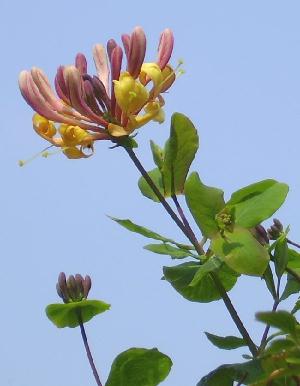
Lonicera caprifolium
Honeysuckle is deciduous, although some of the japonica varieties like Halliana shown below are evergreen in mild winters. Honeysuckle flowers often vary greatly in colour, the most common are cream becoming orange, but shades of pink and red are seen also. The flowers bloom between May and October, depending on the variety, and are generally tubular, twin-lipped, highly-fragrant and hang in clusters.
Our native honeysuckle (Lonicera periclymenum) comes into flower in late May to early June, spreading its wonderful fragrance through the air particularly in the evening when the scent is at its strongest. The powerful aroma attracts bees, moths and butterflies to its sweet nectar. It is a climbing shrub that can grow up to 8 metres high if left unchecked. The flowers give way to red berries which are toxic if eaten.
There are over 180 species of honeysuckle in the lonicera family ranging from short evergreen shrubs with no flowers to the vigorous, wonderfully-scented climbers found in many gardens around the world. The climbers are great for covering fences, trellises or garden arches and combine well with clematis. To get the best display from your honeysuckles, mix a few that flower at different times of the year, such as the early flowering Lonicera periclymenum 'Belgica' and the later flowering Lonicera japonica 'Halliana' both of which mingle well with roses and will give you a continuation of flower, colour and scent.
Growing
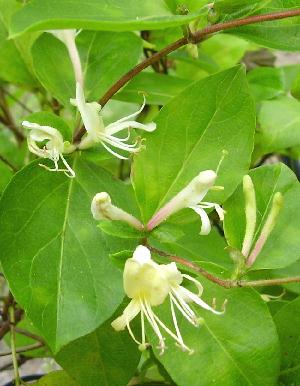
Lonicera japonica 'Halliana'
To plant a honeysuckle, dig a hole larger than the root ball about 30 cm from a fence or wall and add compost. Fill the hole with soil so that it is level to the top of the root ball, firm in and water well. Remember to keep your honeysuckle moist through the summer during its first year. Honeysuckles need support and occasionally they also need a severe pruning. Left unchecked they can bring down fences with their weight. Approximately three years after planting, remove one in three of the shoots near to ground level after flowering, choosing the oldest of the shoots. Doing this will maintain a good display of flowers in subsequent years.
General Use
The wood has been used to make walking sticks because of its nature to grow around and entwine saplings. The dried flowers are used for adding to pot-pourri, herb pillows and floral waters. Also, scented cosmetics are made from the fresh flowers.
A less known fact about the honeysuckle family is that Lonicera tatarica Tatarian honeysuckle, a leggy bush honeysuckle with sweet scented pink flowers, is used as a substitute for catnip. The wood contains nepetalactone which is the active ingredient found in catnip.
Medicinal Use
Culpeper stated that only the leaves of the honeysuckle were used medicinally to treat coughs, sore throats and for opening obstructions of the liver and spleen. Gerard had the flowers steeped in oil down as being good to help warm and soothe the body that is very cold. Matthew Robinson in his New Family Herbal shared Culpeper's view that honeysuckle leaves helped the spleen and liver. Matthew also advocated that the flowers are boiled in water and used as a poultice with a little oil added as a cure for hard swellings and impostumes (abscesses).
The leaves and flowers of the honeysuckle are rich in salicylic acid, so may be used to relieve headaches, colds, flu, fever, aches, pains, arthritis and rheumatism. The leaves have anti-inflammatory properties and contain anti-biotics active against staphylococci and coli bacilli. Honeysuckle flowers and flower buds are used in various infusions and tinctures to treat coughs, catarrh, asthma, headaches and food poisoning.
Please note that honeysuckle berries are highly toxic and should NEVER be used on any count.
Culinary Use
The flowers can be used for making teas, vinegars, jams, jellies and add interest to fruit curd. Try making quince and honeysuckle or peach and honeysuckle curd. The flowers can also be used for decorating cakes and desserts and for making country wine.
Recipe
Honeysuckle Wine
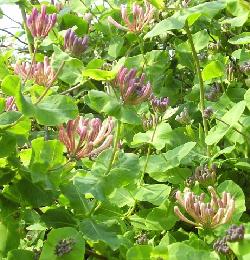
This is one of the first wines I ever made. My hobby started back in 1991 after watching a TV programme called 'Fruity Passions' on the BBC. It was a beginners guide to country wine making, the presenter was a lovely lady called Margaret Vaughan whom I recently had the pleasure of meeting. The programme took my interest in flowers and herbs to a new dimension and I've been a country wine maker ever since, as the line of demijohns up our stairs demonstrates. The recipe below is my variation on the recipe from Margaret's book. Her version was given to her by 'Mrs Smith', a lady from her village who was known for curing asthma and freckles with her honeysuckle wine.
Quantities
- 2 Pints Honeysuckle Flowers
- 2žlb White Granulated Sugar
- 1lb Sultanas, washed & chopped
- 2 Teaspoons Citric Acid
- 1 Orange (Juice of)
- 2 fl oz Earl Grey Tea brewed strong (use 2 tea bags and let steep for 10 minutes)
6 Pints Water - Sachet Sauternes Wine Yeast
You can decrease the amount of sugar to 2˝lb if you prefer a dry wine. Using half white and half golden granulated sugar adds a rather unusual taste to the wine
Method
- Using only the flower heads rinse them under the tap and shake off as much water as possible (I use a salad spinner to dry them).
- Once dry add the honeysuckle petals to you wine fermenting bucket with the sugar, sultanas, orange juice, earl grey tea and the citric acid.
- Add the boiling water and stir the wine until the sugar has completely dissolved.
- Activate the wine yeast following the instructions on the packet and once the wine must is cooled add your yeast starter.
- Cover the wine and leave it for4-5 days depending on the room temperature, the warmer the room the quicker the ferment.
- After the 4-5 days strain your wine into a winemaker's demijohn. If you don't have enough must to fill the demijohn to the neck then top it up with cold boiled water.
- Leave the wine to ferment for approximately3 months. ; By then it should be clear and ready for bottling.
- This wine will end up medium sweet with a wonderful floral aroma and will be a light golden colour. Leave to mature and take out the following year when the honeysuckle blooms.
